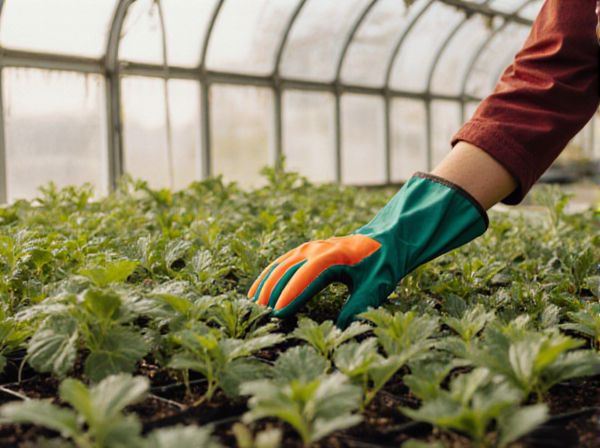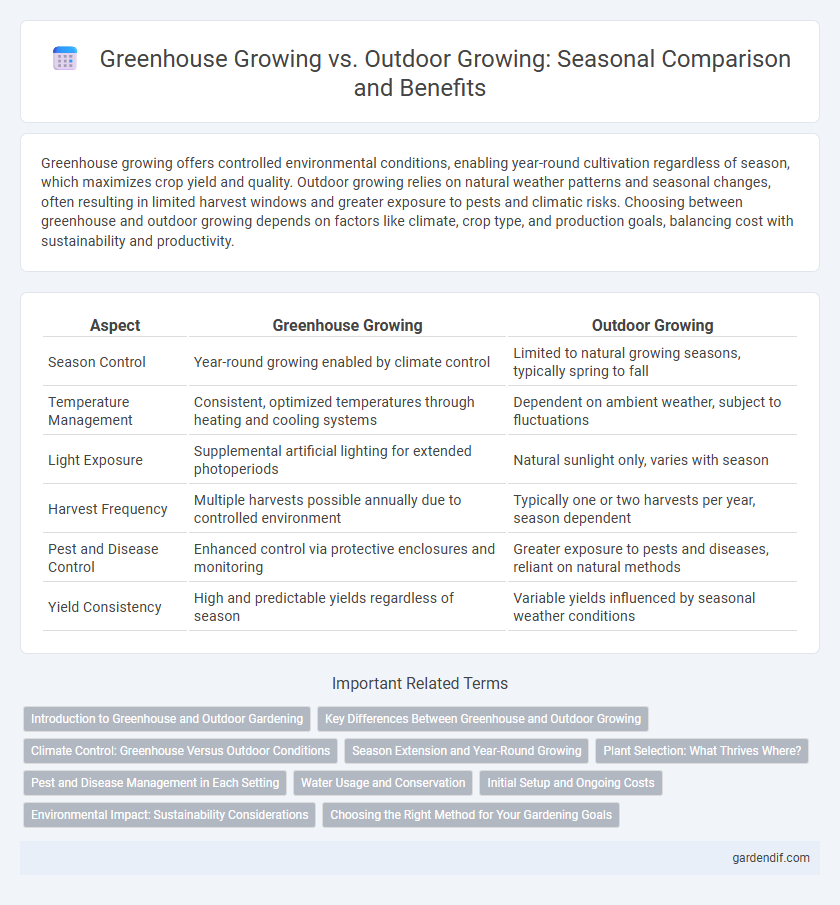
Greenhouse growing vs Outdoor growing Illustration
Greenhouse growing offers controlled environmental conditions, enabling year-round cultivation regardless of season, which maximizes crop yield and quality. Outdoor growing relies on natural weather patterns and seasonal changes, often resulting in limited harvest windows and greater exposure to pests and climatic risks. Choosing between greenhouse and outdoor growing depends on factors like climate, crop type, and production goals, balancing cost with sustainability and productivity.
Table of Comparison
| Aspect | Greenhouse Growing | Outdoor Growing |
|---|---|---|
| Season Control | Year-round growing enabled by climate control | Limited to natural growing seasons, typically spring to fall |
| Temperature Management | Consistent, optimized temperatures through heating and cooling systems | Dependent on ambient weather, subject to fluctuations |
| Light Exposure | Supplemental artificial lighting for extended photoperiods | Natural sunlight only, varies with season |
| Harvest Frequency | Multiple harvests possible annually due to controlled environment | Typically one or two harvests per year, season dependent |
| Pest and Disease Control | Enhanced control via protective enclosures and monitoring | Greater exposure to pests and diseases, reliant on natural methods |
| Yield Consistency | High and predictable yields regardless of season | Variable yields influenced by seasonal weather conditions |
Introduction to Greenhouse and Outdoor Gardening
Greenhouse growing offers a controlled environment that extends the growing season by regulating temperature, humidity, and light, allowing for consistent crop production regardless of external weather conditions. Outdoor gardening relies on natural seasonal cycles and sunlight, making it dependent on climate and weather patterns, which can limit planting and harvest times. Both methods have distinct advantages, with greenhouses enhancing growth efficiency and outdoor gardening providing a natural ecosystem for plants.
Key Differences Between Greenhouse and Outdoor Growing
Greenhouse growing offers controlled environmental conditions such as temperature, humidity, and light, enabling year-round cultivation and protection from pests and extreme weather, unlike outdoor growing which depends heavily on natural seasonal variations and local climate. Crops in greenhouses typically experience faster growth rates and higher yields due to optimized conditions and the ability to extend the growing season beyond traditional outdoor limitations. However, outdoor growing benefits from natural sunlight and lower operational costs but faces challenges like unpredictable weather, pests, and shorter growing periods tied to seasonal changes.
Climate Control: Greenhouse Versus Outdoor Conditions
Greenhouse growing provides precise climate control by regulating temperature, humidity, and light, enabling year-round cultivation regardless of external weather conditions. Outdoor growing depends entirely on natural climate patterns, which can vary significantly by season and region, affecting crop yields and growth cycles. Controlled greenhouse environments minimize risks from pests and weather extremes, optimizing plant health and productivity compared to the unpredictability of outdoor cultivation.
Season Extension and Year-Round Growing
Greenhouse growing enables precise climate control that significantly extends the growing season beyond natural outdoor limits, allowing for year-round crop production regardless of external weather conditions. Controlled environments protect plants from seasonal temperature fluctuations and adverse weather, resulting in more consistent yields and faster growth cycles. In contrast, outdoor growing relies on natural seasons, limiting planting and harvest times but benefiting from natural sunlight and ecosystem interactions.
Plant Selection: What Thrives Where?
Greenhouse growing allows precise control over temperature, humidity, and light, making it ideal for delicate plants like orchids and tomatoes that require stable conditions. Outdoor growing suits hardy crops such as corn, pumpkins, and beans that can withstand natural weather fluctuations and seasonal changes. Selecting plants based on their adaptability--cool-season crops like lettuce thrive outdoors in spring while tropical plants flourish in greenhouses year-round--maximizes yield and health.
Pest and Disease Management in Each Setting
Greenhouse growing offers controlled environments that reduce pest infiltration and allow precise disease management, minimizing the need for chemical interventions. Outdoor growing exposes plants to diverse pest populations and fluctuating weather conditions, increasing vulnerability to infestations and fungal diseases. Implementing integrated pest management tailored to each setting optimizes crop health and yield throughout the growing season.
Water Usage and Conservation
Greenhouse growing significantly reduces water usage compared to outdoor cultivation by utilizing controlled irrigation systems like drip or hydroponics, which minimize evaporation and runoff. Outdoor growing relies heavily on natural rainfall and often requires frequent watering, leading to higher water consumption and less efficient conservation. Implementing water recycling and rainwater harvesting in greenhouses further enhances water conservation efforts, making it a sustainable choice for seasonally dependent crops.
Initial Setup and Ongoing Costs
Greenhouse growing requires a higher initial investment due to the cost of structure installation, climate control systems, and supplemental lighting, which ensures year-round crop production irrespective of seasonal changes. Outdoor growing involves lower upfront expenses but depends heavily on seasonal weather, necessitating significant investments in pest control and soil preparation each season. Ongoing costs in greenhouses include energy consumption and maintenance, while outdoor cultivation demands variable input costs tied to weather conditions and seasonal labor fluctuations.
Environmental Impact: Sustainability Considerations
Greenhouse growing significantly reduces water usage and pesticide runoff compared to outdoor farming, contributing to better resource management and lower environmental pollution. Controlled environments in greenhouses enable year-round crop production, minimizing land degradation and habitat disruption associated with traditional outdoor agriculture. However, the energy consumption for climate control in greenhouses remains a key factor influencing overall sustainability and carbon footprint.
Choosing the Right Method for Your Gardening Goals
Greenhouse growing offers controlled environmental conditions, extending the growing season and maximizing yield for various crops. Outdoor growing depends on natural seasons, benefiting from sunlight and natural pollinators but facing weather unpredictability. Choosing the right method depends on your goal for crop quantity, quality, and season length, balancing control versus natural growth advantages.
Greenhouse growing vs Outdoor growing Infographic

 gardendif.com
gardendif.com